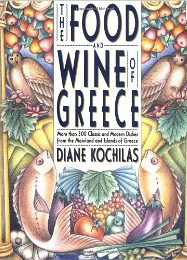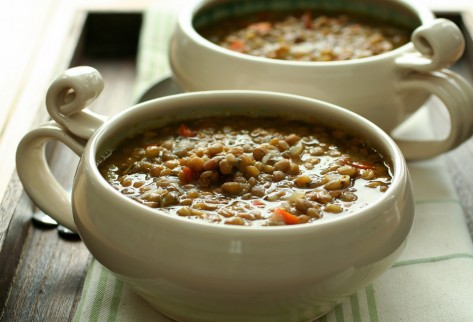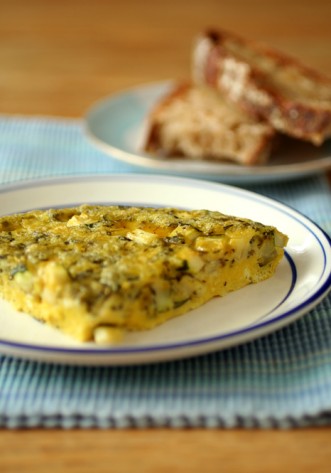The Simple Pleasures of Greek Cooking
 THE FOOD AND WINE OF GREECE
THE FOOD AND WINE OF GREECE
More than 300 Classic and Modern Dishes from the Mainland and Islands of Greece
By Diane Kochilas
St. Martin’s Press
354 pp. $21.95
After preparing some lesser-known Greek dishes from the DCCC pick The Food and Wine of Greece, like Faki (Hearty Lentil Soup), Soutzoukakia Smyrneika (Meatball Sausages, Smyrna Style) and Sfoungato (Baked Omelet), my boyfriend, half-joking, half-not, said, “Greek food doesn’t taste like Greek food.” And he’s right, if you base your understanding of what Greek food is on the handful of iconic dishes and associative ingredients that have become familiar to Americans: Greek salad, Greek omelet, gyro, souvlaki, spanakopitta, stuffed grape leaves, tzatziki (the creamy yogurt and cucumber dip), rice pudding, baklava, Feta cheese, Kalamata olives, olive oil, and oregano. Many of the most famous Greek dishes have long infiltrated diner menus, featured side by side with other “melting-pot” favorites, like Chicken Parmesan or the Reuben, and classic American favorites like hamburgers, grilled cheese, and grilled pork chops. (This is especially true where there are pockets of Greeks immigrants; Detroit, Michigan, and the surrounding area, being one notable example.)

Faki (Hearty Lentil Soup) (This soup is topped with a drizzle of olive oil and chopped raw onions for crunch, both of which I forgot for the photo.)

Sfoungato (Baked Omelet)
On the other hand, it’s much harder to find restaurants serving only Greek food, and offering dishes beyond the most well known. So, for most of us, the only way to challenge our assumptions of what Greek food is—and to realize first-hand just how little we actually know of it—is to roll up our sleeves and start cooking. If you’re new to Greek cooking, The Food and Wine of Greece is a great choice for exploring what the cuisine has to offer. It is relatively inexpensive and is packed with recipes from all over Greece. Most are traditional, which will give you an authentic flavor foundation. Art is scarce—there are some drawings to liven the page, some useful line art “how-to’s” here and there, and a helpful map in the introduction—but in exchange, as mentioned above, you get a lot of recipes—more than 300 in all.
Of the recipes DCCC members tried, stand outs are Saganaki (Fried Cheese), Dolmakakia Yialantzi(Rice-stuffed Grape Leaves), Meat-stuffed Grape Leaves, Lima Bean Skordalia (Lima Bean and Garlic Puree), Piperies Florinis (Red Peppers, Florina Style), Anginares à la Polita (Artichoke Stew, Constantinople Style), Lahanodolmades (Stuffed, Rolled Cabbage Leaves), Mihali’s Shrimp with Feta Cheese, Braised Rabbit with Olives, Soutzoukakia Smyrneika (Meatball Sausages, Smyrna Style), Koulourakia me Kimino Kai Sousami (Olive Oil Biscuits with Cumin and Sesame), and Karythopitta (Rich Walnut Torte).
In the introductory sections of the book, Kochilas gives a thorough overview of “The Essentials of Greek Cuisine,” which includes a discussion of wine, spirits, and other beverages; the basic ingredients, with an enlightening description of the multitude of Greek cheeses (there is so much more than feta!); and sauces and dressings. She describes how Greek cuisine is, at its best, a simple, home-cooked fare using the freshest, seasonal ingredients. While one could argue that every cuisine is at its best when the freshest, best-quality ingredients are used, after cooking several recipes—about 20 in all, but a mere fraction of what’s included in the book—I began to understand just how simple and “honest” Greek food is both in preparation and flavor, making it ultra important to use just the freshest, seasonal ingredients. The biggest punch of flavor may come from the generally copious use of garlic; otherwise, the repertoire of herbs, spices, and sauces is limited and their use restrained, allowing the flavors of the main ingredients to shine through. (Chili pepper is used in some dishes, but very rarely.) Two of the biggest surprises for me was the common use of fresh dill and acids—lemon juice, red wine vinegar, wine, and/or tomatoes—which are used to heighten the simple but delicious flavors of the dishes.
Its very reliance on the freshest possible, locally grown and produced ingredients, and its rather subdued but straightforward flavor profile, may make traditional Greek food under appreciated today—in a time when many of us have become accustomed to big flavors* and/or using ingredients that are well-traveled and commercially produced, and thus less flavorful, or simply have a thirst for something novel. Case in point: earlier this month, in the Food Network’s “Throwdown with Bobby Flay,” Diane Kochilas lost a competition for the best moussaka to Flay, whose versionincluded nontraditional ingredients such as goat cheese, Serrano chili pepper, and dried currants. (Read Kochilas’s account of the event here.)
According to Kochilas, in a piece she wrote this past summer for the Washington Post, Greeks, during their current economic crisis, and after nearly two decades of eschewing the “classless tavern” and embracing trendy “high-design” restaurants featuring contemporary Greek-inspired fusion cuisine or the cuisines of other cultures, are turning back to the traditional, simple foods of their homeland. An upside of this period of run-away culinary exploration was the dramatic increase in quality of Greek wines, giving them international recognition of late. (The 2010 Aug/Sept issue of Saveur is devoted entirely to the foods and great wines of Greece.)
So do as the Greeks are doing now. Enjoy some traditional Greek foods prepared in your own kitchen and reward yourself with a bottle of Greek wine—one of the great, increasingly available wines, of the world. And be sure to use fresh, in-season produce to experience the cuisine as it’s meant to be; two DCCC members mentioned to me that they plan to return to The Food and Wine of Greece this summer to try some more recipes, to do just that.
*Pondering Flavor. One club member said she felt that Greek food, at least the more traditional foods which are the mainstay of The Food and Wine of Greece, seemed bland to her. She is drawn to big flavors—she’s a fan of Mexican and Indian food—and this, compounded by the fact that the Greek cookbook followed on the heels of the Indian cookbook, Entice with Spice, may, by comparison, have done the Greek food a disservice, making it seem particularly under spiced to her. Her comment made me realize that as the club progresses from one cookbook, and one cuisine, to another, our impression of each will be influenced by where we’ve been, particularly when moving from a bold cuisine to a quieter one. Should we orchestrate our global cookbook travel like wine tasting, progressing from whites to reds, and from subtler to bolder? That would take some of the surprise out of what we do. Perhaps all we need is a palate cleanser, figurative and real, between books.
